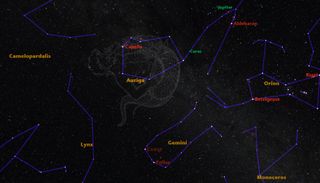Capella: The Goat Star

Capella is a bright star in the constellation Auriga. While Capella appears as a single star to the naked eye, it actually is a group of four stars — two large binary stars, and two fainter binary dwarfs. It has been identified as a source of X-rays, likely because of the strength of its corona or surrounding gas envelope.
Locating Capella
At a magnitude of 0.08 and more than 40 light-years away, it's the sixth-brightest naked-eye star in Earth's night sky. Sometimes known as the "Goat Star", Capella's yellow-orange appearance at times makes it hard to distinguish the star from the planet Mars. It's visible for most of the year in the Northern Hemisphere. [The Brightest Stars in the Sky: A Starry Countdown]
Capella's position is:
- Right ascension: 05 hours 15 minutes 41.4 seconds
- Declination: +45 degrees 59 minutes 53 seconds

A tangled history
Capella lies in Auriga, which is sometimes known as the charioteer. The constellation, however, has a mix of legends associated with it. The Greeks and the Romans associated the asterism with chariots, and legends said Auriga was good at training horses and also invented the four-horse chariot.
The most ancient stories, according to SPACE.com skywatching columnist Joe Rao, said that Auriga was a goatherd and the guiding light for shepherds. It is for this reason that Capella is sometimes referred to as the "Goat Star." Three stars in a triangle nearby are meant to be her children.
"The confusion in concepts is reflected in the ancient allegorical pictures and star names," Rao wrote. "Auriga is usually represented holding a whip in one hand in deference to the Charioteer story, but in his other arm he is holding a she-goat (Capella) and her three kids."
Bigger and brighter than the sun
Once astronomers were able to turn powerful enough telescopes to Capella, the one star was actually revealed to be a binary, with two dwarf binaries as well.
The brightest part is two yellow stars that are about the sun's temperature, but quite a bit brighter and bigger — about 10 times the sun's diameter, according to NASA. Despite their huge size, the stars are only about 60 million miles apart, or two-thirds of the distance between the Earth and the sun.
About one light-year away from these two stars is another binary set of red dwarf stars, which are much fainter.
Recent astronomical observations
A few decades ago, Capella was identified as a potential source of X-rays. Astronomy using that type of wavelength of light didn't come to the fore until the 1960s and 1970s, at which time several observatories turned their attention to the star. Observations continue today.
For example, data obtained with the Chandra X-ray Observatory that were released in 2000 indicated that Capella's binary system has superheated gas, or plasma, across a variety of temperatures. The observations also suggested that Capella's corona, or gas that surrounds it, likely has small loops compared with the radius of the stars.
Some astronomers have also worked on refining the orbits and masses of the stars as telescopic equipment improves. One set of observations released in 2011, and using spectroscopy, was said to be the most accurate to date.
Join our Space Forums to keep talking space on the latest missions, night sky and more! And if you have a news tip, correction or comment, let us know at: community@space.com.
Get the Space.com Newsletter
Breaking space news, the latest updates on rocket launches, skywatching events and more!

Elizabeth Howell (she/her), Ph.D., is a staff writer in the spaceflight channel since 2022 covering diversity, education and gaming as well. She was contributing writer for Space.com for 10 years before joining full-time. Elizabeth's reporting includes multiple exclusives with the White House and Office of the Vice-President of the United States, an exclusive conversation with aspiring space tourist (and NSYNC bassist) Lance Bass, speaking several times with the International Space Station, witnessing five human spaceflight launches on two continents, flying parabolic, working inside a spacesuit, and participating in a simulated Mars mission. Her latest book, "Why Am I Taller?", is co-written with astronaut Dave Williams. Elizabeth holds a Ph.D. and M.Sc. in Space Studies from the University of North Dakota, a Bachelor of Journalism from Canada's Carleton University and a Bachelor of History from Canada's Athabasca University. Elizabeth is also a post-secondary instructor in communications and science at several institutions since 2015; her experience includes developing and teaching an astronomy course at Canada's Algonquin College (with Indigenous content as well) to more than 1,000 students since 2020. Elizabeth first got interested in space after watching the movie Apollo 13 in 1996, and still wants to be an astronaut someday. Mastodon: https://qoto.org/@howellspace
